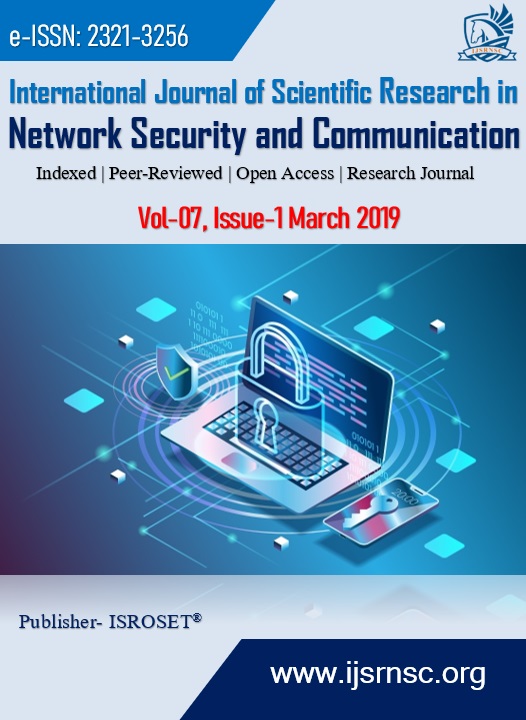Ceramic Tool Condition Monitoring in Machining of Inconel 718
Keywords:
Tool condition Monitoring, Dominant features, Acoustic Emission, Grey relation analysis, AnovaAbstract
There is an in-depth discussion in this paper about the improvement of a system regarding tool wear monitoring in hard turning operation. Acoustic emission (AE) signals from metal cutting processes have been investigated for various purposes, including in-process tool wear monitoring. Hard turning is a machining process Nickel based alloys are difficult-to-machine materials which are widely used in various applications. Tool wear is a major problem in these materials because of their high hardness. The present study is focusing on Inconel 718 with varying HRC (51, 53, and 55) and the tool employed here is ceramic. By using L9 orthogonal array extracted from taguchi method, taking input parameters such as speed, feed, depth of cut and hardness. Taking vibration signal data as an input to ANOVA and Grey relation analysis (GRA) which identifies the optimal and most dominant feature (Root Mean Square(RMS), Crest Factor(CF), Skewness(Sk), Kurtosis(Ku), Absolute Deviation(AD), Mean, Standard Deviation(SD), Variance, peak, Frequency and Time in the tool wear operation.
References
E.O.Ezugwu,Key, “Key improvements in the machining of difficult to cut aero space super alloys”, International Journal of Machine Tools and Manufacture, vol.45, issues.12–13, pp.1353–1367, 2005.
ChaoXue,WuyiChen, “Adhering layer formation and its effect on the wear of coated carbide tools during turning of a nickel-based alloy”, Wear, vol.270, issues.11–12, pp.895–902,2011.
A.Munoz-Sanchez, .A.Canteli,J.L. Cantero, M.H.Migue lez, “Numerical analysis of the tool wear effect in the machining induced residual stresses”, Simulation Modelling Practice and Theory, vol.19, issue.2, pp.872–886,2011.
S.Olovsjo, L.Nyborg, “Influence of microstructure on wear behaviour of uncoated WC tools in turning of Alloy 718 and Wasp alloy”, Wear, vol.282, issue.283, pp.12–21, 2012.
Altin,M.Nalbant,A.Taskesen, “The effects of cutting speed on tool wear and tool life when machining Inconel 718 with ceramic tools”, Materials Design, vol.28, issue.9, pp.2518–2522,2007.
Xiaozhi C, Beizhi L, “AE method for tool condition monitoring based on wavelet analysis”, Int J Adv Manufacturing Technology, vol.33, issue.9-10 pp.968-976,2007.
Micheletti CF, Koening W, Victor HR, “In-process tool wear sensors for cutting operations”,Ann CIRP, vol.25, pp.483-496, 1976.
Ravindra HV, Srinivas YG, Krishnamurthy R, “Modeling for tool wear based on cutting forces in turning”, Wear, vol.169, issue.1, pp.25-32, 1993.
LI Dan, J. Mathew, “Tool wear and failure monitoring techniques for turning a review”, Int. J.Machine Tools Manufact. Vol.30, Issue.4, pp.579-598, 1990.
Damodara samy S, raman S, “Inexpensive system for classifying tool wear states using pattern recognition”, Wear, vol.170, issue.2, pp.149-160, 1993.
Kannatey-Asibu E Jr, Dornfeld DA, “A study of tool wear using statistical analysis of metal cutting acoustic emission”, Wear, vol. 76, issue.2, pp.247-261, 1982.
Jemielniak K, Bombinski S, “Hierarchical strategies in tool wear monitoring”, Proc IME B J Eng Manuf, vol.220, issue.3, pp.375–381, 2006.
Dimla De, “sensor signals for tool wear monitoring in metal cutting operations: A review of methods”, Int J Machine Tool manuf, vol.40, issue.8, pp.1073-1098, 2000.
Moriwaki T, Tobito M, “A new approach to automatic detection of life of coated tool based on AE measurement”, Trans ASME J England, vol.112, issue.3, pp.212-218, 1990.
Blum T, Inasaki I, “A study on AE from the orthogonal cutting process”, J England, vol.112, issue.3, pp.203-211, 1990.
Rangwala S, Dornfeld D, “Sensor integration using neural networks for intelligent tool conditioning monitoring”, ASME J England, vol.112, issue.13, pp.219-228, 1990.
Heiple CR, Carpenter SH, Armentrout DL, McManigle AP, “AE from single point machining : source mechanisms and signal changes with tool wear”, Mater Eval, vol.52, issue.5, pp.590-596, 1994.
Cho ss, Komvopoulos K, Correlation between AE and wear of multi-layer ceramic coated carbide tools” Journal of Manuf Sci Eng, vol.119, issue.2, pp.238-246, 1997.
Chungchoo C, Saini D, “A computer algorithm for flank and crater wear estimation in CNC turning operations”, .Int J of Machine Tool Manuf, vol. 42, issue.13, pp.1465-1477, 2002.
Scheffer C, Kratz H, Heyns PS, Klocke F “Development of a tool wear monitoring system for hard turning”, Int J machine Tool manuf, vol. 43, issue.10, pp.973-985, 2003.
Sun J, Hong GS, Rahman M, Wong YS, “Improved performance evaluation of tool condition identification by manufacturing loss consideration”, Int J of Production research, vol. 43, issue.6, pp.1185-1204, 2005.
Bhuiyan M, Choudhary I, Yusoff N, “A new approach to investigate tool condition using dummy tool holder & sensor setup”, Int J Adv Manuf Technnology, vol.61, issue.5-8, pp.1-15, 2011.
Kondala Rao D, Srinivas K, “An analysis of feature identification for tool wear monitoring by using acoustic emission”, Traitment du signal, vol.34, issue.3-4, pp.117-135, 2017.
Downloads
Published
How to Cite
Issue
Section
License

This work is licensed under a Creative Commons Attribution 4.0 International License.
Authors contributing to this journal agree to publish their articles under the Creative Commons Attribution 4.0 International License, allowing third parties to share their work (copy, distribute, transmit) and to adapt it, under the condition that the authors are given credit and that in the event of reuse or distribution, the terms of this license are made clear.









